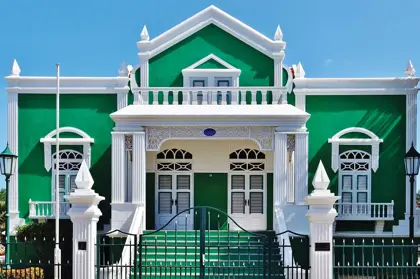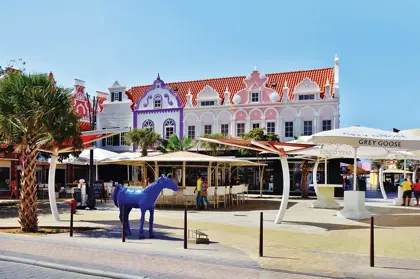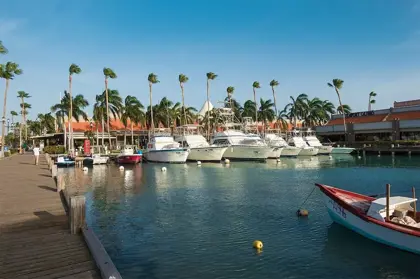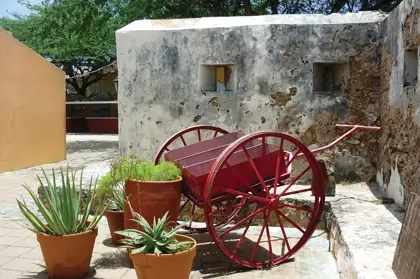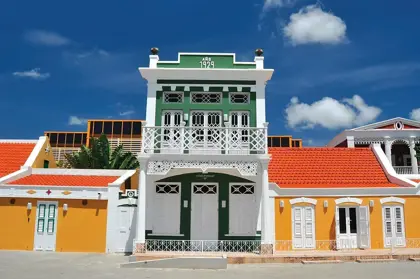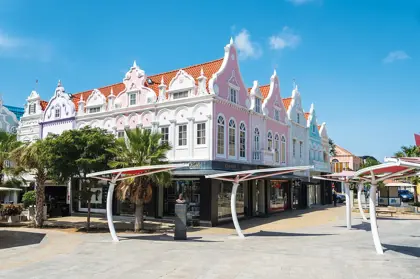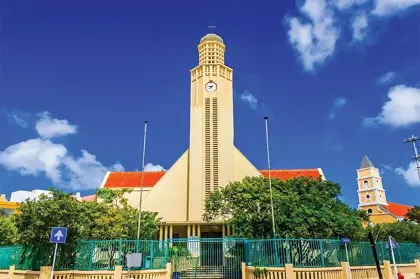What to do in Oranjestad Aruba
Discover what to do in Aruba. Oranjestad Aruba has everything; chic boutiques, architectural gems, exciting shopping malls, quaint restaurants, hip nightclubs, and an ambience unmatched anywhere else on the island. Add some history to your next outing by heading downtown and following our tour.
Start at Wilhelmina Park
Queen Wilhelmina was the longest-reigning Dutch monarch, ruling the Netherlands from 1898 to 1948. Wilhelmina Park, with its marble statue of Queen Wilhelmina amidst tropical gardens, was laid out in her honor in 1955. There is also a lovely statue of Anne Frank here, the base of which is inscribed with a very moving quote from her book. Just outside this waterfront park and to the left of Oranjestraat, are Aruba’s parliament buildings, built after the island gained Status Aparte (semi-independence) in 1986. Looking west you’ll see Renaissance Marketplace and the harbor beyond. This one-story complex has a wide variety of shops and restaurants selling beachwear, jewelry, and gifts, and serving everything from sushi to lattes.
Walk north up Oranjestraat (heading inland)
Aruba’s first lighthouse, called Willem III Tower, was built in 1868. Time stands still not only on its clock, but also in the Historical Museum behind, where old photographs of the island are on display. The museum is housed in Fort Zoutman, construction of which began in 1796 to defend Paarden Bay. With fortress walls only 10 feet high, it seems improbable that it could withstand attack, but it did, against the English in 1799. Soon after, houses were built in its line of fire as Oranjestad began to grow. Nowadays, the Bon Bini Festival, with dancing, arts and crafts stands, and local food, is held here every Tuesday evening.
Continue up Oranjestraat to Wilhelminastraat
The red building to the left is the Hotel Colombia, considered the first hotel on Aruba. Mr. Nadi Henriquez, who later set up the first open-air cinema, built it in 1918. Connected to it is the striking Eloy Arends Manor on Wilhelminastraat, Oranjestad’s most authentic street. One of Aruba’s most regal homes, it is now the Town Hall and is often used for weddings. Eloy Arends was an Aruban physician and he built the home for his fiancée, Maria Laclé. During their engagement from 1922 to 1925 (it takes some time to build a mansion!), Ms. Laclé was obliged to avoid the neighborhood. The doctor’s good sisters furnished the house during their honeymoon. No accounts were left of how the bride felt about her in-laws’ choice of décor!
Explore further east on Wilhelminastraat
Several buildings along Wilhelminastraat are, at their core, traditional cunucu, or country houses. These characteristic Aruban houses are low with a sloping roof rising to a saddle roof in the center. They were usually built facing the wind for natural air conditioning and plastered in ground coral. The building at number 27 is the oldest, dating to 1877. Most cunucu front patios have become shops and eateries, but the farther east you walk, the more authentic the houses.
Return and head west on Wilhelminastraat
The oldest surviving church on Aruba is the Protestant Church built in 1846, between Schoolstraat and Rifstraat. The building stones of the church come from the house that previously occupied the lot. Called the “Church on the Bay” because of its visibility from Paarden Bay, it displays beautiful woodwork inside and is still used for special occasions.
Continue west to Plaza Daniel Leo
Plaza Daniel Leo is Oranjestad’s most picturesque square with its colonial-style buildings. The decorative Dutch gables were inspired by those on Amsterdam’s canals, but are splashed with pastel Caribbean colors. Many of these now contain tiny boutiques and duty-free shops.
Walk to the north end of the square Caya G.F.
Betico Croes or Mainstreet runs from the square to the east. Still more shops line this lively street, selling everything from cameras to clothing and jewelry. Heading in the other direction is Schelpstraat. The restored Ecury Complex, a historic trading house at number 42, is now home to the National Archaeological Museum of Aruba. The collection of buildings includes two cunucu houses from 1867 and 1870. Inside the museum, a 4,000-year-old skull, shell jewelry, and ceramic figurines guide you through Aruba’s indigenous heritage. Schelpstraat has some impressive, restored cunucu houses. The grand Henriquez House (number 36-38), with its extra story, dormers, and terracotta roof tiles imported from Holland, is a more typically urban version of the cunucu.
Walk down towards Havenstraat and follow it back towards the center of town
Nearby Havenstraat also boasts its share of historic homes, as well as shopping and fine dining. If shopping is what you’re after, take some time to explore Royal Plaza Mall and Renaissance Mall both of which overlook the yacht basin and cruise ship terminal.
Do you want to know more about what to do in Aruba? Just read one of the related articles below to make your vacation unforgettable!
by Dianna Beaufort

